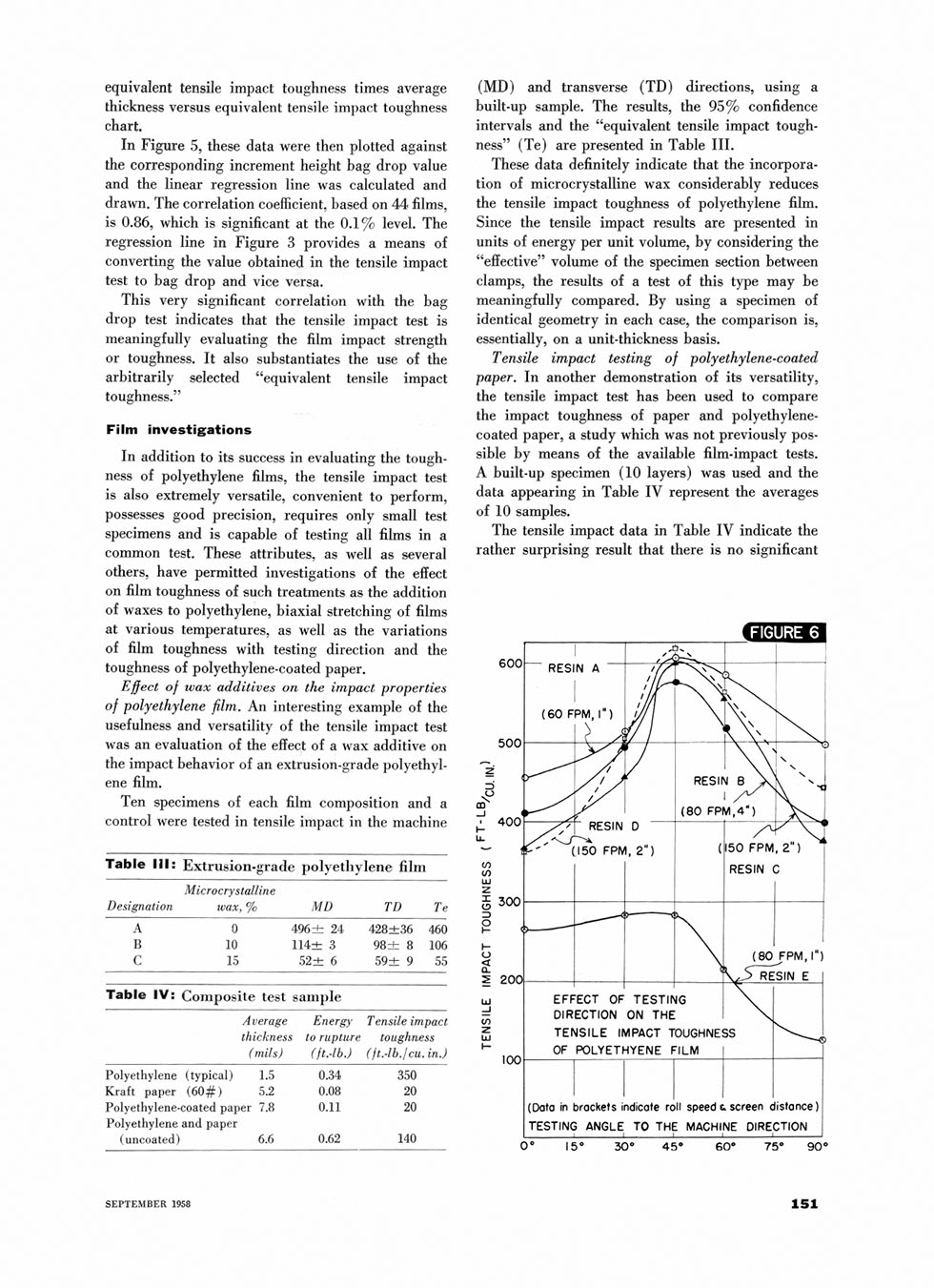


equivalent tensile impact toughness times average thickness versus equivalent tensile impact toughness chart.
In Figure 5, these data were then plotted against the corresponding increment height bag drop value and the linear regression line was calculated and drawn. The correlation coefficient, based on 44 films, is 0.86, which is significant at the 0.1% level. The regression line in Figure 3 provides a means of converting the value obtained in the tensile impact test to bag drop and vice versa.
This very significant correlation with the bag drop test indicates that the tensile impact test is meaningfully evaluating the film impact strength or toughness. It also substantiates the use of the arbitrarily selected "equivalent tensile impact toughness."ť
Film investigations
In addition to its success in evaluating the toughness of polyethylene films, the tensile impact test is also extremely versatile, convenient to perform, possesses good precision, requires only small test specimens and is capable of testing all films in a common test. These attributes, as well as several others, have permitted investigations of the effect on film toughness of such treatments as the addition of waxes to polyethylene, biaxial stretching of films at various temperatures, as well as the variations of film toughness with testing direction and the toughness of polyethylene-coated paper.
Effect of wax additives on the impact properties of polyethylene film. An interesting example of the usefulness and versatility of the tensile impact test was an evaluation of the effect of a wax additive on the impact behavior of an extrusion-grade polyethylene film.
Ten specimens of each film composition and a control were tested in tensile impact in the machine
Table III: Extrusion-grade polyethylene film
|
Designation |
Micro crystalline wax, % |
MD |
TD |
Te |
|
A |
0 |
496± 24 |
428±36 |
460 |
|
B |
10 |
114± 3 |
98 ± 8 |
106 |
|
C |
15 |
52± 6 |
59 ± 9 |
55 |
Table IV; Composite test sample
|
Average thickness ( mils) |
Energy to rupture (ft,lb.) |
Tensile impact toughness (ft.-lb.leu. in.) | |
|
Polyethylene (typical) |
1.5 |
0.34 |
350 |
|
Kraft paper (60#) |
5.2 |
0.08 |
20 |
|
Polyethylene-coated paper 7.8 |
0.11 |
20 | |
|
Polyethylene and paper (uncoated) |
6.6 |
0.62 |
140 |
(MD) and transverse (TD) directions, using a built-up sample. The results, the 95% confidence intervals and the "equivalent tensile impact toughnes-ť (Te) are presented in Table III.
These data definitely indicate that the incorporation of microcrystalline wax considerably reduces the tensile impact toughness of polyethylene film. Since the tensile impact results are presented in units of energy per unit volume, by considering the "effective"ť volume of the specimen section between clamps, the results of a test of this type may be meaningfully compared. By using a specimen of identical geometry in each case, the comparison is, essentially, on a unit-thickness basis.
Tensile impact testing of polyethylene-coated paper. In another demonstration of its versatility, the tensile impact test has been used to compare the impact toughness of paper and polyethylene-coated paper, a study which was not previously possible by means of the available film-impact tests. A built-up specimen (10 layers) was used and the data appearing in Table IV represent the averages of 10 samples.
The tensile impact data in Table IV indicate the rather surprising result that there is no significant